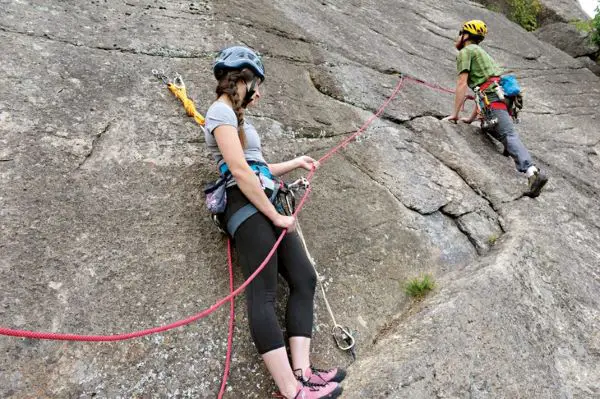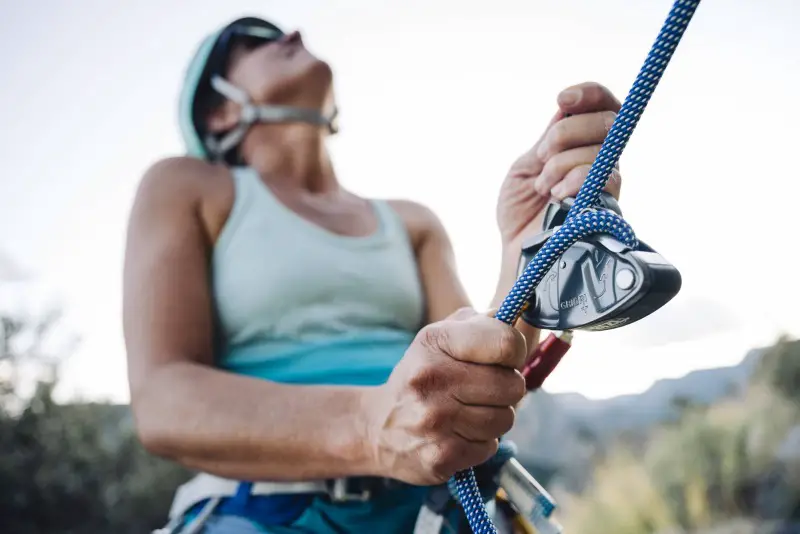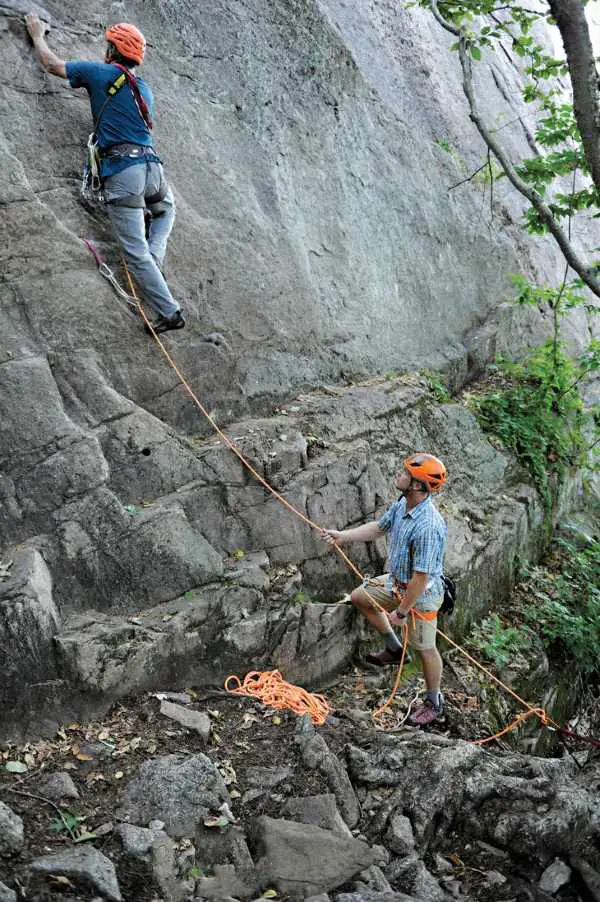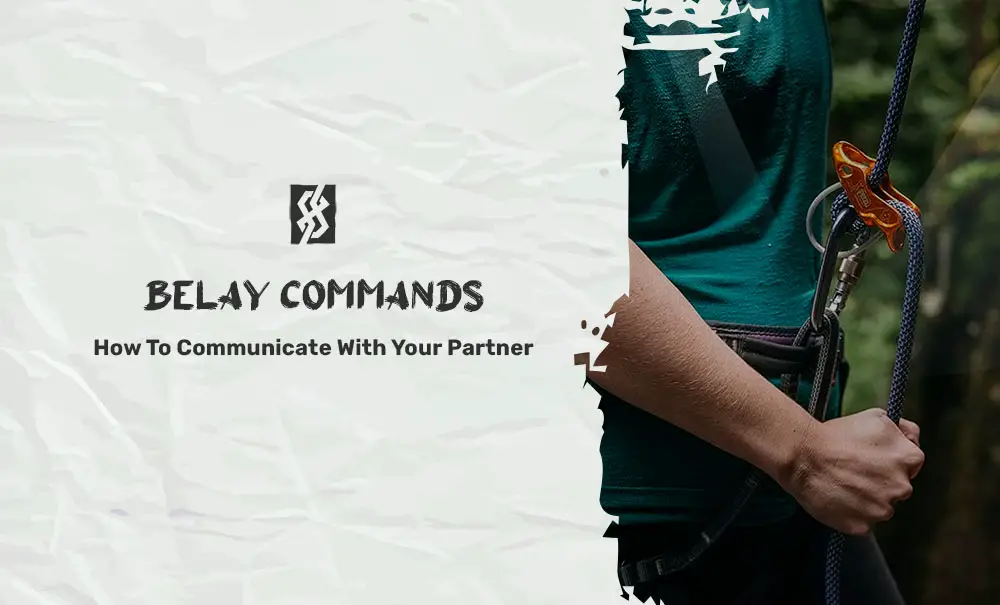“On belay!” – whether you started climbing 30 years ago or yesterday, this is the first command that you’ll hear whenever you start climbing with a rope.
In a sport where meticulous safety measures reign supreme, with gear designed to withstand the unthinkable, it’s the human touch that truly makes the difference. Clear, concise communication isn’t just a nicety—it’s a lifeline.
Remember, belaying isn’t just a skill—it’s a responsibility. Always seek training from a certified professional if you are not sure how to belay properly. After all, as the age-old adage reminds us, when you’re on belay, you hold a life in your hands.
What Are Belaying Commands?
In rock climbing, as you might have already noticed, we use all sorts of different jargon and language. These rock climbing belay commands and forms of communication ensure that the lead climber always keeps the belayer up to date with his process of climbing the rock.

Why use belay commands? As soon as the belayer receives a command like “take”, “slack” or “clipping” he will know what to do, whether to create tension in the rope, give some more slack, keep a sharp eye on the climber or expect a fall. Good communication keeps both climbers safe meaning that you’ll have a great time at the crag or gym!
On Belay – What Does It Mean?
Usually, rock climbing implies there is a climber and a partner; the belayer. What does this second person have to do?
So one of the most important words from the climbing lingo is “belay”. This refers to the technique that rock climbers use in ensuring the safety of the climber by applying tension on the rope so the climber doesn’t fall to the ground if he slips off a hold or wants to come down. The belayer is usually a person who sits on the ground or a belay spot on the wall, ensuring that the lead climber is safe and sound on the rock.

The belaying starts when the lead climber clips in the first quickdraw, up until then, the belayer’s responsibility is to spot his partner and break his fall if he happens to slip.
Before you can give your friend the “climb on” command, which means he can get on the rock, a safety protocol should be followed, a protocol that we usually call buddy check.
The buddy check protocol consists of:
Verifying the knots – check the climber’s knot and see if it’s tied correctly. A loose or wrong knot can send you into Broken Bones Land very fast. Some climbers usually tie an extra “safety knot” or ‘’stopper knot’’ to stop the main one from untying.
Check your buckles – make sure that both your harnesses are secured and tightly fastened. A loose harness can be uncomfortable and unsafe.
The belay device – check if the rope goes through the belay device and is secured by a locked carabiner. Some people feel comfortable with an ATC device which is simpler to utilize but requires more attention, while others prefer the assisted-belay device which automatically locks when the climber falls, adding an extra layer of protection.
If you are climbing without someone who you haven’t spent much time with, make sure you are both on the same page when it comes to commands.
Belay on! – Belaying Technique, Do’s & Don’ts
“Belay on!” means that the climber is safe on the belayer’s gear and can give the “climbing” command.
When belaying a climber, you should always have a proper technique which includes good rope management, stance, and hand positioning.
Regarding rope management, be always sure to have your brake hand on the rope. Remember, your friend’s life depends on it, and even if you use an assisted-belay device such as the Petzl GriGri it can slip if you let go of the rope.

Proper belay stance is important to help you maintain your balance and will help you to be quick on your feet when you need to catch your partner. Keeping your knees bent and one foot forward, with a relaxed body is the most common belayer stance. Of course, ALWAYS keep your eye on the climber, because sometimes mistakes can happen quickly.
Before starting climbing or giving the “climb on” command, remember to check your rope isn’t tangled so it can flow smoothly through the belay device as you feed rope to your climbing partner.
Rock Climbing Belay Commands
After going through all of this theory on how to properly belay, let’s take a look at the most common rock climbing belay commands, starting from “On belay” to “Belay off”.
A typical conversation between climbing partners would go like this:
C: on belay?
This is the climber assuring that the belayer is ready to belay
B: belay on!
This is the confirmation that is always necessary before the climber gets on the rock
C: climbing
Lead climber gets on the wall
B: climb on
Belayer is ready to catch the climber in case something happens
C: clipping
The lead climber has clipped in one of the quickdraws
C: climbing
Right after clipping, the climber continues his climb
C: take
The climber needs some more tension on the rope as he is in a tough spot and might take a fall
B: taking
The belayer takes the slack
C: falling
The climber is ready to take a fall
B: got you
Belayer ensures the climber that he’s safe
C: slack
While climbing, the climber needs some more slack on the rope
C: ready to lower
The climber is ready to come back to the ground
B: lowering
The belayer confirming that he began lowering
The term “off belay” can be used in a few situations. In some cases, the lead climber is still up on the rock and wants to rappel by himself, in this case, he will announce to the belayer that he is on his own. He will wait for the belayer’s command “belay off” so that he will know when he can start rappelling.

If the climber needs to clean the route, meaning he is the last one up and has to take all the gear down with him, the climber will clip himself into safety. Here, the climber will say ‘I’m on safety’ or ‘I’m off belay’. Once the climber has cleaned the anchors he will let his belayer know to ‘take’ slack in and that he’s ‘coming on belay’ again.
Also, “off belay” can be used when the climber has touched the ground and is safe.
And that’s how a solid belaytionship between two climbers flourishes. Use very effective words can enjoy your favorite spot safely! 🙂
Take a look at this informative video on how to belay with a GriGri from Petzl:

FAQs
.


